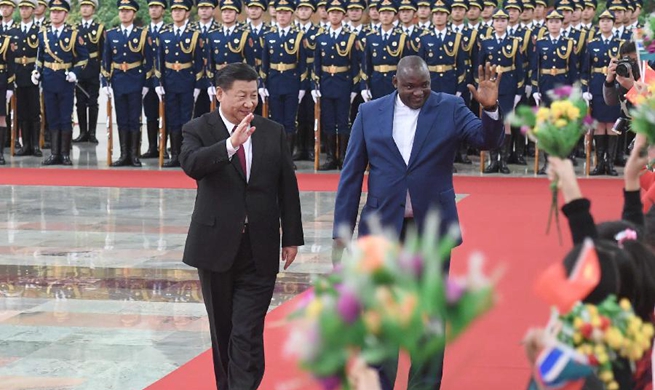by Mahmoud Fouly
CAIRO, Dec. 21 (Xinhua) -- More than 40 million people are suffering hunger in the Near East and North Africa Region (NENA) due to wars and conflicts, according to the latest 2017 report of the Food and Agriculture Organization (FAO) on food security and nutrition in the region.
Released on Thursday, the report states that 40.2 million people are suffering undernourishment and hunger while some 55.2 million are going through severe food insecurity due to conflicts in the NENA region.
The NENA countries are mostly Middle Eastern and Arab states, including Egypt where the FAO regional headquarters is based, Syria, Iraq, Yemen, Libya, Sudan, Saudi Arabia, the United Arab Emirates, Kuwait, Bahrain, Qatar, Oman, Jordan, Lebanon, Mauritania, Tunisia, Algeria, Morocco and Iran.
"This year, the FAO report shows that conflicts are the main reason behind the deteriorating conditions of food security and nutrition in the NENA region, as over 40 million people are suffering hunger in the region with 75 percent of them living in five war-torn states," said Abdessalam Ould Ahmed, FAO's regional chief for NENA and the organization's assistant director general.
The region has been the most tense worldwide throughout history. Since the so-called Arab Spring uprisings that started about seven years ago and toppled some powerful Arab leaders, turmoil has further hit Syria, Iraq, Libya and Yemen, with Lebanon suffering political instability and the Palestinian-Israeli peace process facing a deadlock.
The FAO 2017 report states that 27.2 percent of all people of NENA's war-affected countries are chronically hungry, or undernourished, during the 2014-16 period, highlighting Syria, Iraq, Yemen and Libya as "hot spots" of regional conflicts.
Taking Syria as an example, the country's ongoing crisis that erupted in March 2011 has claimed the lives of about half a million and displaced and wounded over 14 million others.
"The costs of conflicts and wars are not restricted to the level of food security but it also extends to the human level, as the NENA region includes the largest number of displaced people, and the issue has its large social and economic impacts too," Abdessalam Ould Ahmed, FAO's regional chief, told Xinhua after releasing the 2017 report in Cairo.
Ahmed emphasized that the effects of wars on agriculture in Syria, for example, have been estimated at 16 billion U.S. dollars.
"There are some countries that spend 20 to 60 percent of its GDP on coping with wars and violence, which is such a high cost," he lamented.
The FAO report highlighted peace in this region as the only means to eradicate hunger by 2030, which is one of the UN millennium development goals agreed on by world states.
"There must be collaboration, collective work and adoption of comprehensive policies to face poverty, starting with the pressing humanitarian needs of some states and supporting resilience, development and reconstruction in conflict-stricken countries," the FAO regional chief said.
Undernourishment and malnutrition, which are widely spreading in the region due to civil wars and conflicts over the past few years, have made the United Nations World Food Program (WFP) dedicate half of its annual budget to NENA suffering states.
Since March 2015, a Saudi-led Arab alliance has been launching airstrikes against Iran-backed Shiite Houthi rebels in Yemen, a group that helped overthrow Yemeni President Abd-Rabbu Mansour Hadi and killed former President Ali Abdullah Saleh after he turned against them.
The Yemeni crisis has left some 20.7 million people in need, over 2 million internally displaced, according to the report of the UN High Commissioner for Refugees (UNHCR) released on Dec. 18.
"The WFP along with its partners provide food aids for more than 7 million people in Yemen and over 6 million in Syria and its neighboring states, in addition to several other Arab states and countries in the Middle East and North Africa," WFP regional director Muhannad Hadi told Xinhua, noting that the WFP budget for 2018 is 9 billion U.S. dollars.
"Unfortunately, due to the ongoing conflicts, more than half of the WFP budget goes to the Middle East region and the Arab world. For example, we need more than 1 billion dollars for Yemen and the same amount for Syria in the coming year 2018," he added.
In Libya, a civil war has also been taking place for years, leaving the state divided between two rival administrations, one based in the capital Tripoli and the other in the eastern city of Tobruk.
The FAO 2017 report serves as a source of data and information for the massive, nonstop work of the WFP and the UN organizations.
The report also focuses on the fundamental factors that have driven improvements in food security and malnutrition, including violence cessation, poverty reduction, economic growth, better maternal and childhood nutrition and public health and higher food quantity and quality.

















